Like humans, guinea pigs need a healthy dose of vitamins and minerals daily to maintain good health. Cavies are herbivores, so their diet should consist entirely of plant-based foods, but that can get boring if they’re always eating the same things.
Serving fresh veggies daily is a great way to maintain your guinea pig’s diet. Vegetables are an excellent source of nutrients and fiber. Besides that, they’re delicious, and there aren’t any hidden ingredients to worry about.
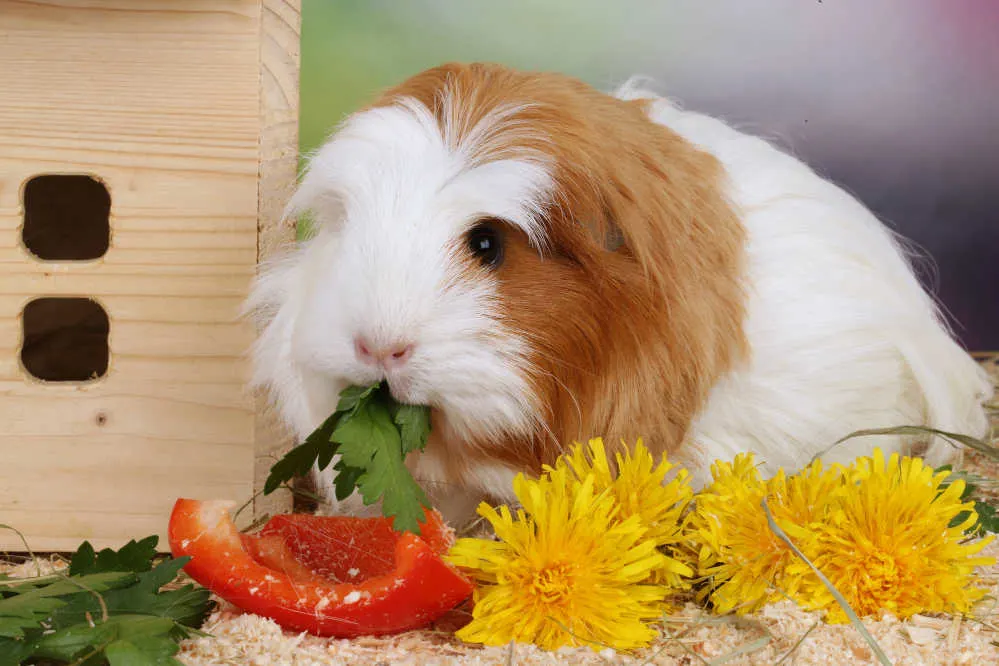
While fresh veggies every day may keep the vet at bay, some vegetables are better for your guinea pig than others. Being aware of the guinea pig-safe fresh fruits and vegetables is essential as a cavy owner.
This article will dive into all the details of the best veggies for cavies.
Why should guinea pigs eat fresh vegetables?
Many guinea pig owners think that veggies are good for guinea pigs only because of the fiberthey provide. It’s actually the vitamins found in fresh vegetables that cavies need most, mainly vitamin C. But that doesn’t mean that fiber isn’t important. Fresh vegetables are extremely high in dietary fiber compared to the processed veggies found in guinea pig pellets.
Pellets can be great for cavies too, but they’re more likely to contain harmful additives like salt, preservatives, or artificial sugars, which you won’t find in good quality fresh veggies. Certain vegetables can be high in sugar, but natural sugar is much easier for piggies (and humans) to digest than artificial stuff.
Other vitamins and minerals found in vegetables are of great importance too; in fact, they’re essential to having a healthy and happy guinea pig. Cavies need plenty of vitamin C, but also vitamin K, and folic acid (the natural form of vitamin B9), among many other natural nutrients.
Besides being nutritious, munching on fresh veggies is also very enriching for guinea pigs. They generally appreciate a variety of textures and flavors, and you might even find that their preferences change as they age.
What vegetables are safe for guinea pigs to eat?
Your guinea pigs will benefit from a well-balanced diet consisting of a variety of fresh veggies and high-quality grass hay. Generally, most vegetables are safe for cavies, but there are some that you shouldn’t serve every day because of their high concentrations of natural sugar or minerals.
Here are a few different types of vegetables that are safe for guinea pigs to eat regularly.
Leafy greens
Leafy green vegetables are an excellent source of vitamins, minerals, and fiber for guinea pigs. They are especially high in vitamin C, vitamin K, and folic acid, as well as essential nutrients and minerals like calcium and iron.
Because leafy green vegetables contain high levels of nutrients, it’s important to slowly introduce them to your guinea pig’s diet — as is the case with most new foods. Ideally, cavies should be eating about one cup of vegetables per day with most of that consisting of leafy greens.
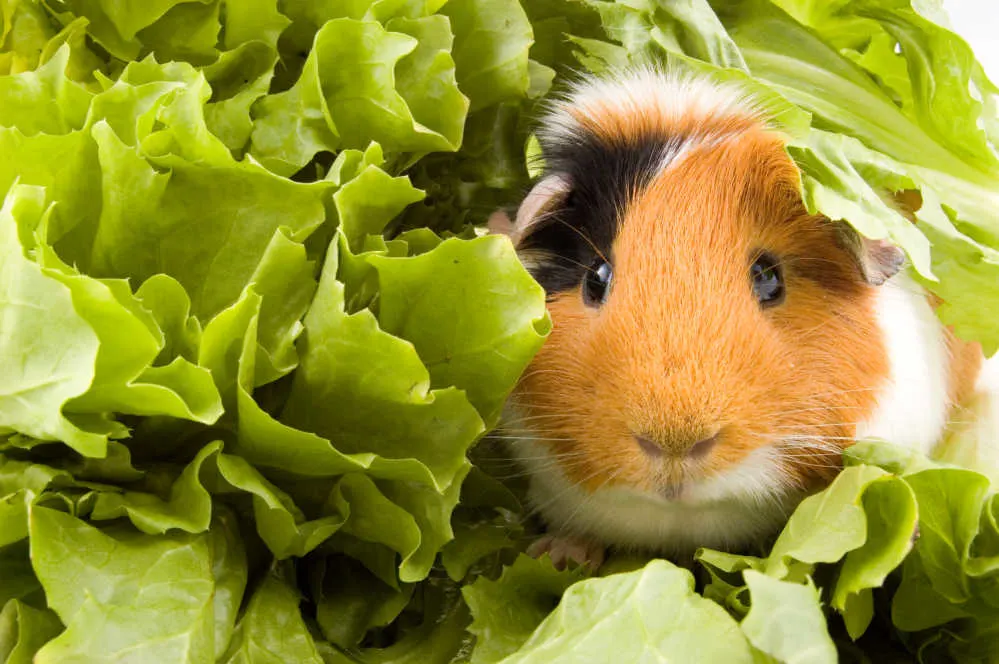
Guinea pigs should have a daily serving of greens such as romaine lettuce or red or green leaf lettuce which are high in vitamins C and K. Other greens, like kale, spinach, swiss chard, and bok choy, are fantastic sources of minerals like calcium, iron, and magnesium. At the same time, both red and green cabbage contain high levels of dietary fiber and folic acid.
To ensure your piggies have a balanced diet, prepare a cup of chopped greens each day with a bit of lettuce, cabbage, kale, and spinach.
Yellow, red, or green bell peppers
In terms of preference, bell peppers can be touch-and-go with guinea pigs. Cavies can be fussy about what they take in, and peppers are something they either love or hate. There is also a bit of debate around which kind of pepper is best for guinea pigs, but overall, yellow peppers come out on top.
Yellow peppers for cavies are a wonderful source of vitamin C, and they’re lower in sugar than other peppers. While it’s not ideal that they have yellow peppers every day, serving peppers as a crunchy snack a few times a week is recommended.
All peppers are great for improving guinea pigs’ eye health because they contain such high levels of beta-carotene and vitamins C and A. Yellow peppers also contain vitamin B6, which promotes calmness and better sleep.
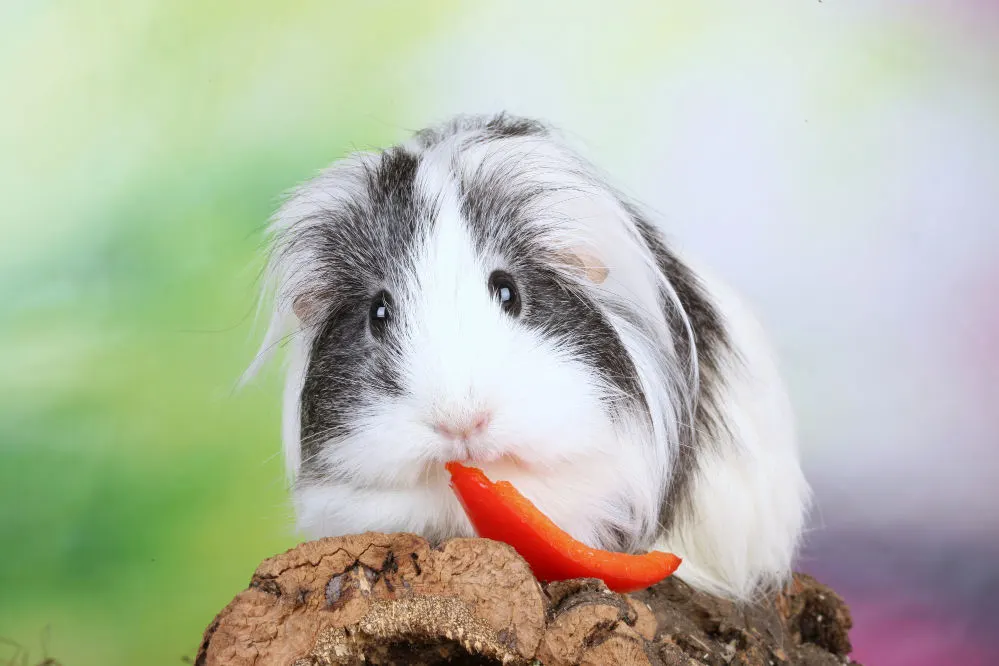
Root vegetables
Root vegetables include pretty much everything that grows underground, such as carrots, sweet potatoes, turnips, radishes, celeriac, and parsnips, to name just a few. These buried treasures are generally great for guinea pigs but should only be eaten a few days a week.
Alternating between peppers and root vegetables, along with a serving of leafy greens every day, is a great way to add variety to your guinea pig’s weekly menu. Because they grow underground, root veggies are higher in minerals like iron, calcium, and potassium, which come from the soil.
Feeding your guinea pigs small amounts of root vegetables is good for their eyes, teeth, and bones. But too much calcium and starch can cause digestive problems, so make sure not to overdo the calcium-rich veggies.
Tomatoes
Fully-grown guinea pigs can eat one small cherry tomato every day, provided it is ripe, and the stem and leaves have been removed. Tomatoes are very high in antioxidants, vitamin C, fiber, and potassium, which are essential to your pet guinea pig.
However, they are also very acidic; like with humans, an excess of highly-acidic foods can be detrimental to guinea pigs. Cavies tend to enjoy tomatoes, and their unique texture is certainly enriching, but too many tomatoes can cause Cheilitis, a condition caused by an excess of oxalic acid.
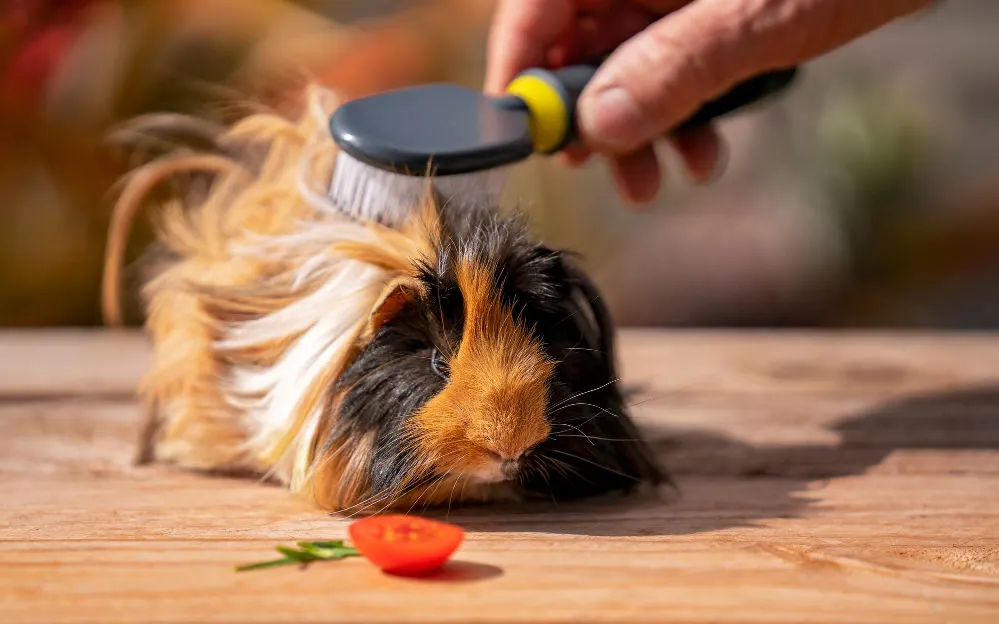
Tomato stems and leaves are toxic to guinea pigs, so you should always remove them when feeding them to your guinea pig. If you notice that your guinea pig has an upset stomach, it can be a sign that they’re eating too many tomatoes.
Gourds/ Squashes
Gourds and squashes include fresh veggies such as pumpkins, butternut squash, zucchini, and even cucumbers. Typically, green gourds such as zucchinis and cucumbers have little nutritional value compared to other vegetables but are very high in fiber. They are safe for guinea pigs to eat often. But, as with any food, they should be eaten in moderation.
Pumpkins and butternut squashes are rich in vitamins A, C, and B, but are even better for their high levels of fiber and natural sweetness. Cavies generally love munching on squash but don’t appreciate the skin.
Before feeding your guinea pig, you should ensure that the squash is peeled, cut into small pieces (about the size of a coin), and any seeds have been removed.
Herbs
Herbs such as parsley, basil, mint, dill, and thyme are safe foods for guinea pigs to eat a few times a week. Despite their strong taste, they are also generally well received by cavies, and they’re great for their immune systems and general health.
Combining a small amount of herbs with your cavies’ daily greens is the perfect way to ensure they’re benefitting from the health benefits of fresh herbs. Certain ones, such as dill, even contain helpful enzymes which are beneficial to your guinea pig’s digestive system.
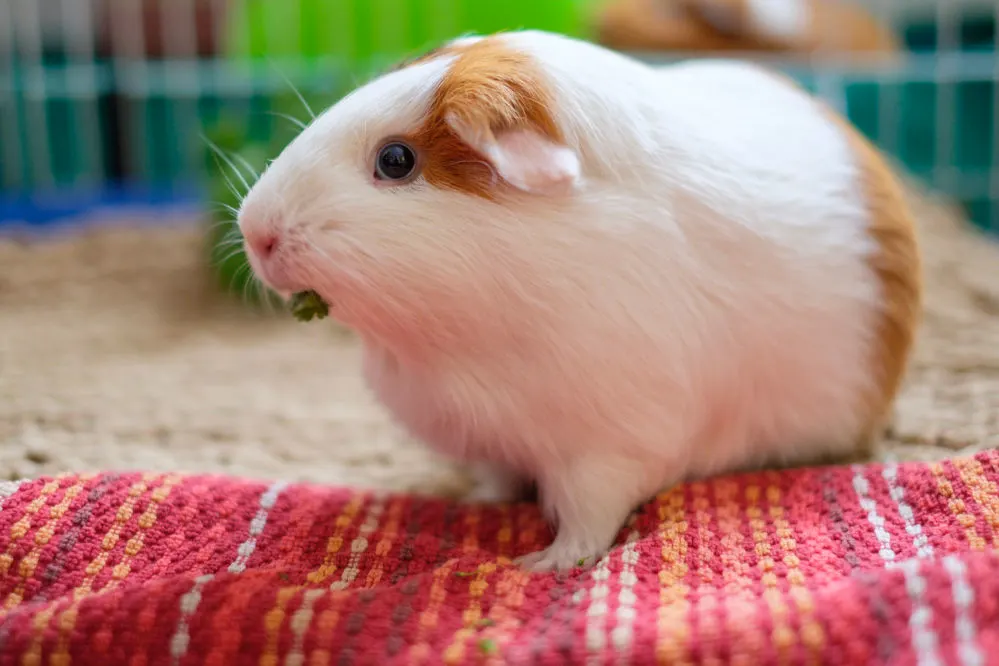
For guinea pigs with anxiety or poor sleep schedules, small amounts of herbs like chamomile and peppermint might assist in calming them down. Herbs have high levels of vitamins K and C but also contain calcium, so they shouldn’t be served with other high-calcium foods to avoid digestive upsets.
Celery
Celery is one of the best vegetables for guinea pigs to eat. It contains the vitamins that guinea pigs need the most, such as vitamin C, as well as a high level of dietary fiber. The stalks of celery plants also have a high water content, which makes them a nutritious and hydrating snack.
This vegetable has more benefits than its vitamins and minerals, though. It’s also very enriching for cavies to munch on celery because of its crunchy texture, and it helps to keep their teeth and mouths clean.
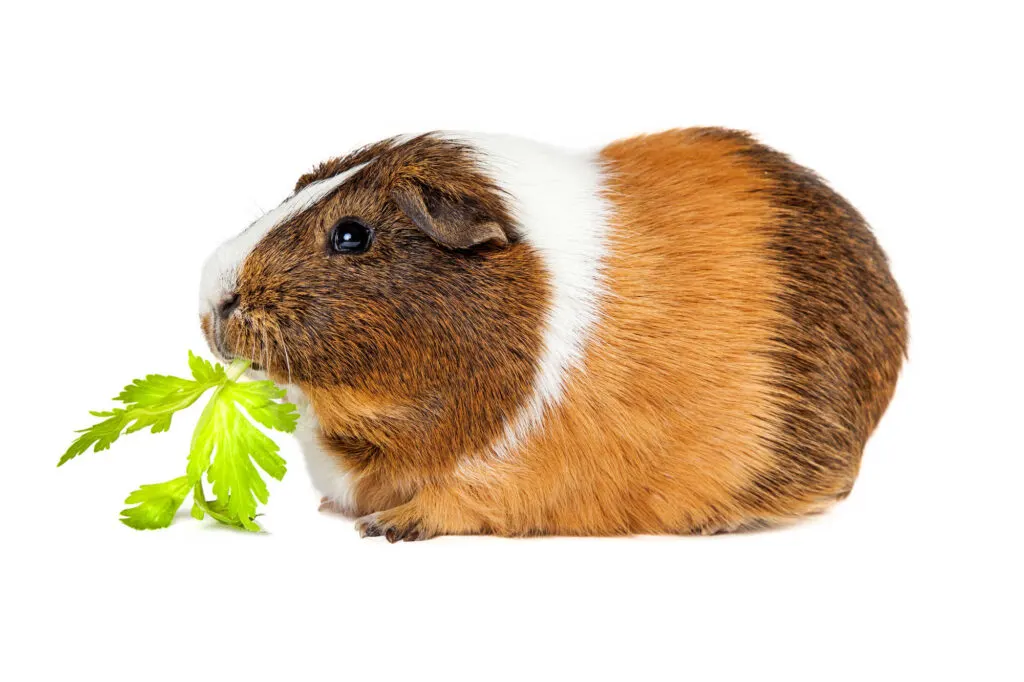
You can give your guinea pigs celery on most days, skipping one or two in between for variety. Simply chop them into comfortable-sized chunks and serve them with a few different vegetables.
Celery is high in fiber, which is essential in a guinea pig’s daily diet. Fiber helps to prevent constipation and maintains a healthy digestive system. However, too much fiber can cause health issues.
Timothy hay
While it isn’t exactly a vegetable, Timothy hay is a nutritious plant food that you can feed your guinea pig every day. Fresh hay is packed with vitamins and nutrients that are essential for cavies in order to have a healthy diet.
You should provide your guinea pigs with a bowl of fresh veggies and a good amount of Timothy hay to eat every day. This hay and similar foods like orchard grass hay and alfalfa hay should be kept off the ground in a hay feeder and away from bedding hay to prevent contamination. Designating a separate area for feeding is essential when considering the size of your cavies’ cage.
Timothy hay for guinea pigs provides a good balance of fiber, vitamins, fats, and proteins. It also has a fragrant smell which cavies love, and is pleasant for humans to be around, too.
While it’s excellent for your piggies to have some hay daily, it should not make up the entirety of their diet. Healthy guinea pigs will have a combination of fresh vegetable and hay diets.
What vegetables are not suitable for guinea pigs?
Guinea pigs generally take well to most veggies in moderation. However, there are a few vegetables that are not recommended for guinea pigs that you should take note of. Guinea pigs should avoid eating foods such as:
- Onions, garlic, chives, leeks, or shallots
- Avocados
- Beans
- Rhubarb
- Unripened tomatoes
- The leaves and stalks of tomato plants
- Vegetable seeds
These vegetables in small amounts are not immediately toxic to guinea pigs, so there’s no need to rush to the vet if they have consumed a small amount. But seeds and beans can be a choking hazard, so it’s important to monitor your cavy very closely or take them to the vet if they have consumed any.
How to prepare veggies for guinea pigs
Wash everything thoroughly, even if you have grown the vegetables in your own garden. Pesticides, bug repellents, and fertilizers are dangerous to all animals, especially small pets like guinea pigs.
All veggies should be thoroughly washed with clean water before serving them to cavies.
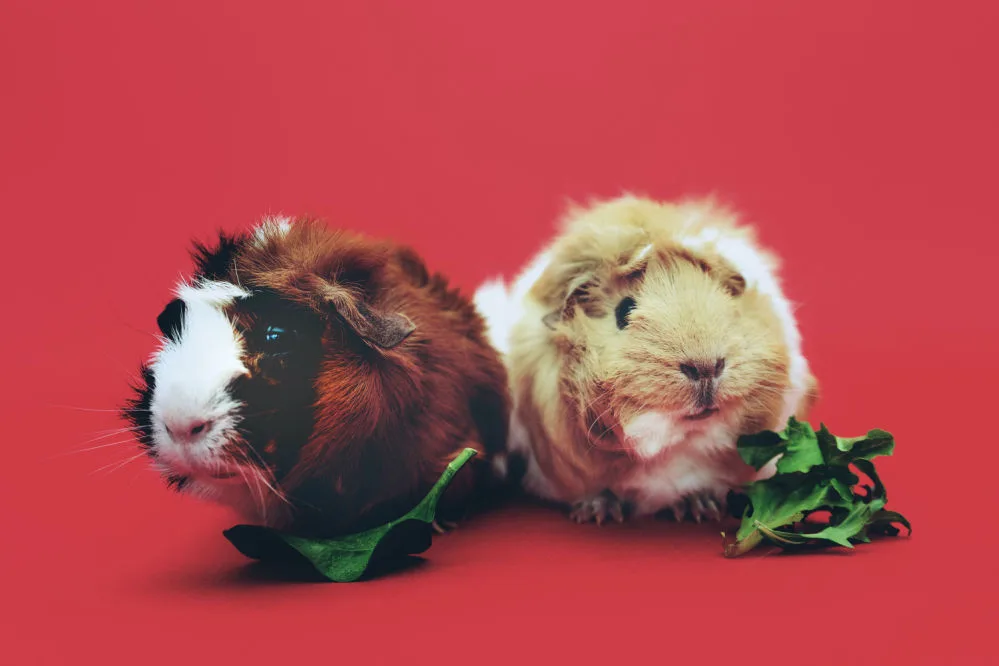
You should chop the veggies into comfortable-sized pieces (this will depend on the size of your guinea pig), but you should ensure they are not small enough to be a choking hazard.
Peppers, celery, and greens can be cut into strips as if you were making a chunky cole-slaw for humans.
Other veggies like root veggies, gourds, and squashes should be julienned (cut into long thin strips) or into coin-sized chunks. All fresh food should be accompanied by fresh water in a water bowl or water bottle.
Guinea pigs should eat from heavy stainless steel or ceramic bowls that won’t tip over if they rest their little feet on them while munching. These are available at most pet stores or online.
Which veggies work well as guinea pig treats?
Everyone deserves a little treat at least once a week. Artificially sweetened products like animal treats are not suitable for guinea pigs, even though they are sometimes marketed towards cavies. Sticking to delicious natural alternatives is always a wise choice if you have your guinea pig’s health in mind.
For a treat once or twice a week, you can give your guinea pig a small serving of a safe vegetable with a high sugar content, such as corn or beetroot. Simply plop in a bit of corn on the cob or a slice of beetroot and watch your cavy happily munch away.
With corn, make sure to remove the cob once they’re done, as the hard cob is not suitable for guinea pigs to eat.
Final tips on the best veggies for guinea pigs
Now that you know which veggies are good for cavies and which to avoid, you’re all set to whip up a delectable menu for your furry friends.
Although most vegetables go down well with guinea pigs, some can be picky eaters, and you might need to try a few different combinations before you find the perfect menu.
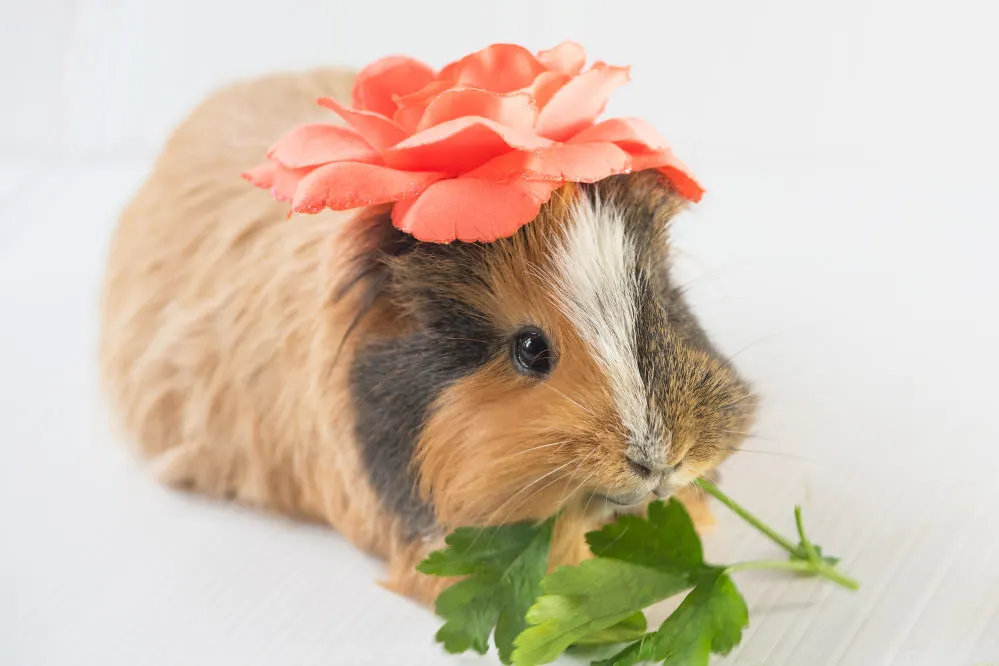
Overall, the best way to ensure your cavy is benefitting from a healthy diet is by monitoring your guinea pig’s fecal production and general well-being when new foods are introduced. Remember that some cavies can be more sensitive than others, and finding the perfect diet can take some time.
If you enjoyed this diet guide, take a look at this post on the best cages for cavies.
Steph Dyson is a travel journalist by trade but a lover of all small pets. She’s been a pet mum to everything from gerbils to guinea pigs, rabbits to hamsters, and fish to dogs of all shapes and sizes. She wants to share her years of experience with small pets and make Small Pet Guides the go-to website for pet owners seeking information and care advice.

